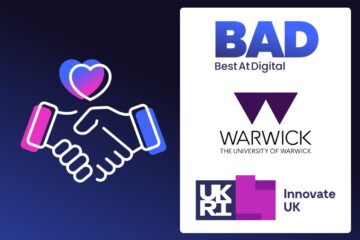Spotlight on learning trends in the telecommunications industry
Published by Francesca Hazel on
Spotlight on learning trends in the telecommunications industry
Table of contents
The telecommunications industry has never been more competitive. With today’s digital landscape evolving at the speed of light (well nearly) telcos need to keep up with the current momentum, adapt to change, and invest in learning to develop their people.
So, what are the latest telecommunications industry learning trends? And what does it mean for digital learning and the future?

Building a digital future
McKinsey reports that “Two-thirds of new users are young digital natives with limited access to payment options, such as online banking and credit cards, but have sophisticated expectations of highly personalized and digital interactions with their mobile providers.”
For a telco to quickly identify and meet these customers’ demands, they need to have the people with the right digital native mindset and the skills to adapt.
Digital diversity
Digital diversity in technology, and the private sector in general, is about creating a culture that welcomes new ideas and different perspectives -drawing upon different minds from different areas of technology. This is not only about the solutions and support those telcos provide to their customers, but also how they support the learning and development needs of their people.
Tearing down barriers with technology
At BAD, we are finding there is a shift – with telcos (and other clients) taking a deeper interest in creating a more inclusive learning environment for their people. Inclusivity is also playing a bigger part in their strategy and culture. Embedding accessible technology into their systems and learning programs helps “to both employ and get the best out of brilliant disabled staff, whilst also maximising their ability to engage and do business with customers with disabilities.” Defining inclusion through technology accessibility.
Inclusive design is not about creating a new design genre or a separate specialism. It’s about a general approach to good design and designing products and services that address the needs of the widest possible audience. Working with one of our telco clients, we created their first Level AAA course. Level AAA is the highest possible conformance level in WCAG and, as a result, holds organisations to the highest standard of accessibility.
Compliance isn’t going away
Many of us still have a little groan when we hear the word ‘compliance’ but yes, it is here to stay. However, “what we’re finding heartening is a digital learning trend towards more and more clients starting to take a more enlightened approach to compliance that is less instructional; more cultural.” Digital learning trends: what we can expect to see in 2023. And hopefully, there will also be less groaning.
We work closely with clients to make compliance training more enjoyable and engaging by creating courses that include elements, such as animated videos or storytelling, that people can connect with on a personal level. We also design serious games with interesting characters and realistic situations to bring specific learning situations to life and provide authenticity.
Using behavioural science to support our design process, we reduce superfluous content and break it into small digestible chunks to reduce cognitive overload and make the learning experience more enjoyable, designing content that is easier to retain.
Empowering societies
Progressively more and more consumers across the globe are adopting tech-savvy lifestyles, and many businesses are changing the way they operate in this ever-progressing digital world.
This digital transformation provides the telco industry with significant growth opportunities because the demand for faster and better telecommunications like 5G, high-speed data, digital solutions, and engaging content accessible across multiple digital channels, is continuously increasing.
Telcos are driving the digital future to empower societies by reshaping consumers’ lives and accelerating the economic growth of businesses. This necessitates an ongoing need to develop the capabilities of their people to adapt to new technologies, tools, and products.
Sustainability, digital transformation, and innovation
During the pandemic, the demand for digital connectivity drove an increase in the consumption of energy leading to the effective expansion of the carbon footprint of telcos.
“Smart products and solutions from telcos—e.g., smart agriculture and smart logistics—are already available that can help other industries reduce their carbon emissions by an amount up to 10 times the telco industry’s own emissions. This ‘customer enablement’ is becoming a key measure of a telco’s environmental performance and a major avenue for boosting its B2B business.” BCG
Many telcos are integrating sustainability into their processes and internal systems to become more energy efficient, and some are implementing artificial intelligence (AI) energy solutions to help support the reduction of these emissions and energy costs.
AI-powered chatbots, like ChatGPT, offer the potential to revolutionize the way the telecommunications industry communicates – providing more efficient, faster, and personalised support for their clients.
These developments in technology require the telco workforce to continually adapt, learn and develop.

The metaverse
With the evolution of the metaverse, the increase of remote working post-pandemic, and the emergence of Gen Z (the first digitally native and genuinely global generation), the way we experience, interact, learn and work continues to evolve.
In this brave new world, “engagement is high, social experience is critical and virtual identity has a part to play.” What the metaverse means for CSPs and enterprise. Telcos are keen to embrace new technologies to enhance their opportunity and reach, for example, we have seen the development of virtual consumer and employee experiences in the metaverse.
Networks are critical of the metaverse experience, with the growth of virtual and augmented reality (VR/AR) tied to the performance of mobile networks. It’s thought that with the ongoing rise of remote working, the demand for sustainable digital innovation will increase.
Changing behaviour
In this fast-evolving digital environment, and as organisational digital transformations increase, we will see a continual shift in the skills and knowledge required for the telco workforce to ensure they keep up to speed with the changing tech, consumer, and service landscape.
Why not get in touch to find out how we use behavioural science to deliver engaging, measurable digital learning experiences in the telecommunications industry.
Related stories

Moving on up! BAD’s increased growth and performance recognised in 2024 Fosway 9-Grid™
BAD are delighted to have advanced along the highly anticipated 2024 Fosway 9-Grid™ for digital learning.

The inaccessibility of dark patterns
Even if you haven’t heard the phrase Dark Patterns, the chances are you’ve almost certainly come across them — both online and in the physical world.

Do androids dream?
Love it or loathe it, AI technologies already interact with many aspects of our lives. So what have we learned about attitudes towards AI?


